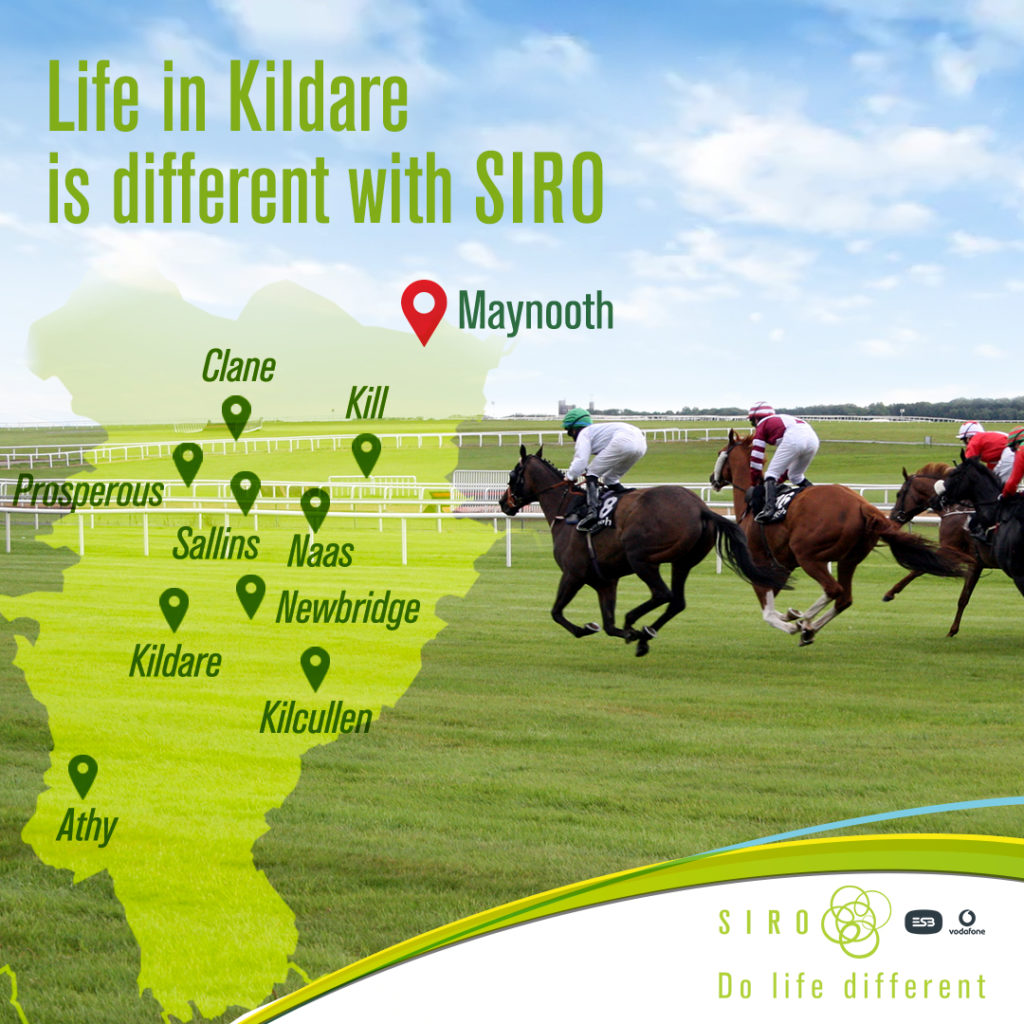 SIRO is a joint venture company between ESB and Vodafone, founded in 2015. SIRO’s state-of-the-art fibre broadband network is built on the ESB electricity infrastructure, trusted for its reliability and resilience. Overall, the company is investing more than €1 billion in delivering high speed, future proofed broadband across Ireland.
Commenting on SIRO’s launch in Maynooth, SIRO CEO John Keaney said:
“Maynooth has been hugely successfully in attracting high quality investment and jobs into the town in recent decades. Added to that its status as home to one of Ireland’s leading universities, makes having high quality, reliable and future proofed connectivity critical.
“SIRO is delighted to announce the arrival of its network in Maynooth. High quality connectivity is now the foundation of how we live, work, study and engage with others. Our network provides a platform for individuals, families, communities, and businesses to do all these activities.
“We are focused on delivering the highest quality of broadband services, a reliable network, and the capacity to meet data demands today, without fear of lag or downtime, but also, future demand with our 10 Gigabit capacity. Our network rollouts in Kildare towns have been hugely positive to date so we are excited to now expand to Maynooth,” added Mr. Keaney
SIRO as an open access wholesaler, partners with 20 broadband retailers across Ireland, to ensure that customers and businesses enjoy greater choice and competition.
Retailers offering SIRO residential or enterprise broadband products include: Digiweb, Sky, Vodafone, Fastcom, Telcom, Viatel and Pure Telecom.
[lookup_modal type="eircode" button-text="Search Your Eircode Today" position="mid" title="Search Your Eircode Today"]
SIRO is a joint venture company between ESB and Vodafone, founded in 2015. SIRO’s state-of-the-art fibre broadband network is built on the ESB electricity infrastructure, trusted for its reliability and resilience. Overall, the company is investing more than €1 billion in delivering high speed, future proofed broadband across Ireland.
Commenting on SIRO’s launch in Maynooth, SIRO CEO John Keaney said:
“Maynooth has been hugely successfully in attracting high quality investment and jobs into the town in recent decades. Added to that its status as home to one of Ireland’s leading universities, makes having high quality, reliable and future proofed connectivity critical.
“SIRO is delighted to announce the arrival of its network in Maynooth. High quality connectivity is now the foundation of how we live, work, study and engage with others. Our network provides a platform for individuals, families, communities, and businesses to do all these activities.
“We are focused on delivering the highest quality of broadband services, a reliable network, and the capacity to meet data demands today, without fear of lag or downtime, but also, future demand with our 10 Gigabit capacity. Our network rollouts in Kildare towns have been hugely positive to date so we are excited to now expand to Maynooth,” added Mr. Keaney
SIRO as an open access wholesaler, partners with 20 broadband retailers across Ireland, to ensure that customers and businesses enjoy greater choice and competition.
Retailers offering SIRO residential or enterprise broadband products include: Digiweb, Sky, Vodafone, Fastcom, Telcom, Viatel and Pure Telecom.
[lookup_modal type="eircode" button-text="Search Your Eircode Today" position="mid" title="Search Your Eircode Today"] SIRO Invests €4 Million In New Full Fibre Broadband Network For Maynooth
SIRO, the broadband network operator, have today launched its new 100% fibre broadband network in Maynooth.
SIRO’s broadband network will bring world class connectivity to 2,500 homes and businesses in Maynooth, with an investment of €4 million in the town.
Areas within the town set to benefit include Main Street, O'Neill Park, Parson Street, Leinster Street, Pound Lane, Dublin Road, Doctor's Lane, Bere Street, Carton Grove, Carton Square, Pebble Hill Park, Limetree Hall, and Back Lane.
With 600 homes and businesses already live and available to order, SIRO’s roll-out in Maynooth to a remaining 2,000 premises is ongoing and expected to complete by end September.
SIRO’s investment in a new broadband network for Maynooth is part of the company’s ongoing fibre rollout across Ireland targeting 154 cities and towns and 770,000 premises.
SIRO’s full fibre network in Maynooth is available to both residential and business customers. Maynooth Business Campus (MBC), which has over 100 national and multinational companies operating within it, is just one of the commercial locations where SIRO is already available. SIRO’s network in Maynooth is 10 Gigabit-enabled which means that enterprise customers can now avail of broadband speeds which will meet their current and further bandwidth requirements.
Maynooth is the ninth Kildare town to go live on the SIRO network, with 30,000 premises in Naas, Athy, Johnstown, Kildare, Clane, Newbridge, Sallins and Prosperous are already able to connect to its future-proofed, gigabit broadband.
 SIRO is a joint venture company between ESB and Vodafone, founded in 2015. SIRO’s state-of-the-art fibre broadband network is built on the ESB electricity infrastructure, trusted for its reliability and resilience. Overall, the company is investing more than €1 billion in delivering high speed, future proofed broadband across Ireland.
Commenting on SIRO’s launch in Maynooth, SIRO CEO John Keaney said:
“Maynooth has been hugely successfully in attracting high quality investment and jobs into the town in recent decades. Added to that its status as home to one of Ireland’s leading universities, makes having high quality, reliable and future proofed connectivity critical.
“SIRO is delighted to announce the arrival of its network in Maynooth. High quality connectivity is now the foundation of how we live, work, study and engage with others. Our network provides a platform for individuals, families, communities, and businesses to do all these activities.
“We are focused on delivering the highest quality of broadband services, a reliable network, and the capacity to meet data demands today, without fear of lag or downtime, but also, future demand with our 10 Gigabit capacity. Our network rollouts in Kildare towns have been hugely positive to date so we are excited to now expand to Maynooth,” added Mr. Keaney
SIRO as an open access wholesaler, partners with 20 broadband retailers across Ireland, to ensure that customers and businesses enjoy greater choice and competition.
Retailers offering SIRO residential or enterprise broadband products include: Digiweb, Sky, Vodafone, Fastcom, Telcom, Viatel and Pure Telecom.
[lookup_modal type="eircode" button-text="Search Your Eircode Today" position="mid" title="Search Your Eircode Today"]
SIRO is a joint venture company between ESB and Vodafone, founded in 2015. SIRO’s state-of-the-art fibre broadband network is built on the ESB electricity infrastructure, trusted for its reliability and resilience. Overall, the company is investing more than €1 billion in delivering high speed, future proofed broadband across Ireland.
Commenting on SIRO’s launch in Maynooth, SIRO CEO John Keaney said:
“Maynooth has been hugely successfully in attracting high quality investment and jobs into the town in recent decades. Added to that its status as home to one of Ireland’s leading universities, makes having high quality, reliable and future proofed connectivity critical.
“SIRO is delighted to announce the arrival of its network in Maynooth. High quality connectivity is now the foundation of how we live, work, study and engage with others. Our network provides a platform for individuals, families, communities, and businesses to do all these activities.
“We are focused on delivering the highest quality of broadband services, a reliable network, and the capacity to meet data demands today, without fear of lag or downtime, but also, future demand with our 10 Gigabit capacity. Our network rollouts in Kildare towns have been hugely positive to date so we are excited to now expand to Maynooth,” added Mr. Keaney
SIRO as an open access wholesaler, partners with 20 broadband retailers across Ireland, to ensure that customers and businesses enjoy greater choice and competition.
Retailers offering SIRO residential or enterprise broadband products include: Digiweb, Sky, Vodafone, Fastcom, Telcom, Viatel and Pure Telecom.
[lookup_modal type="eircode" button-text="Search Your Eircode Today" position="mid" title="Search Your Eircode Today"]
 SIRO is a joint venture company between ESB and Vodafone, founded in 2015. SIRO’s state-of-the-art fibre broadband network is built on the ESB electricity infrastructure, trusted for its reliability and resilience. Overall, the company is investing more than €1 billion in delivering high speed, future proofed broadband across Ireland.
Commenting on SIRO’s launch in Maynooth, SIRO CEO John Keaney said:
“Maynooth has been hugely successfully in attracting high quality investment and jobs into the town in recent decades. Added to that its status as home to one of Ireland’s leading universities, makes having high quality, reliable and future proofed connectivity critical.
“SIRO is delighted to announce the arrival of its network in Maynooth. High quality connectivity is now the foundation of how we live, work, study and engage with others. Our network provides a platform for individuals, families, communities, and businesses to do all these activities.
“We are focused on delivering the highest quality of broadband services, a reliable network, and the capacity to meet data demands today, without fear of lag or downtime, but also, future demand with our 10 Gigabit capacity. Our network rollouts in Kildare towns have been hugely positive to date so we are excited to now expand to Maynooth,” added Mr. Keaney
SIRO as an open access wholesaler, partners with 20 broadband retailers across Ireland, to ensure that customers and businesses enjoy greater choice and competition.
Retailers offering SIRO residential or enterprise broadband products include: Digiweb, Sky, Vodafone, Fastcom, Telcom, Viatel and Pure Telecom.
[lookup_modal type="eircode" button-text="Search Your Eircode Today" position="mid" title="Search Your Eircode Today"]
SIRO is a joint venture company between ESB and Vodafone, founded in 2015. SIRO’s state-of-the-art fibre broadband network is built on the ESB electricity infrastructure, trusted for its reliability and resilience. Overall, the company is investing more than €1 billion in delivering high speed, future proofed broadband across Ireland.
Commenting on SIRO’s launch in Maynooth, SIRO CEO John Keaney said:
“Maynooth has been hugely successfully in attracting high quality investment and jobs into the town in recent decades. Added to that its status as home to one of Ireland’s leading universities, makes having high quality, reliable and future proofed connectivity critical.
“SIRO is delighted to announce the arrival of its network in Maynooth. High quality connectivity is now the foundation of how we live, work, study and engage with others. Our network provides a platform for individuals, families, communities, and businesses to do all these activities.
“We are focused on delivering the highest quality of broadband services, a reliable network, and the capacity to meet data demands today, without fear of lag or downtime, but also, future demand with our 10 Gigabit capacity. Our network rollouts in Kildare towns have been hugely positive to date so we are excited to now expand to Maynooth,” added Mr. Keaney
SIRO as an open access wholesaler, partners with 20 broadband retailers across Ireland, to ensure that customers and businesses enjoy greater choice and competition.
Retailers offering SIRO residential or enterprise broadband products include: Digiweb, Sky, Vodafone, Fastcom, Telcom, Viatel and Pure Telecom.
[lookup_modal type="eircode" button-text="Search Your Eircode Today" position="mid" title="Search Your Eircode Today"]
Additional to Virgin Media’s own network reach of 1m premises, this new partnership enables Virgin Media to offer services to over 450,000 currently enabled SIRO premises throughout Ireland, bringing further competition, value and choice to consumers and businesses nationwide.
Virgin Media has today announced a network deal with SIRO whereby Virgin Media will offer a full range of services to over 450,000 currently enabled SIRO premises throughout Ireland. Virgin Media Ireland already offers 1Gbps (Gigabit per second) broadband speeds to one million premises across Virgin’s own super-fast network. Virgin Media’s expansion will further drive competition and enable ultrafast digital services by helping businesses and communities connect to Virgin’s broadband and digital TV service in many more locations across Ireland.
CEO of Virgin Media, Tony Hanway said: "At Virgin Media we are always pushing the boundaries of speed and service delivery for our customers. Today’s announcement increases our network reach to 70% of all the premises in Ireland. Our new partnership with SIRO means we will be offering our market-leading ultrafast broadband and TV services to more Irish consumers and businesses than ever before.”
SIRO CEO John Keaney, welcoming the agreement between SIRO and Virgin Media noted: “SIRO is an open access wholesaler rolling out full fibre broadband to 154 towns and 770,000 premises across Ireland. Our objective is to deliver our world class connectivity to communities and businesses across Ireland, while constantly bringing innovation to the broadband market.”
 “Thanks, hun! Penney's!” That’s the badge of honour often recited when a woman in Ireland is complimented on their outfit.
Fast fashion, both in Ireland and across the world has been the norm for the last 30 years. It’s not so long ago, people wouldn’t bat an eye to doing large shopping hauls for no real cause. Now, amidst a global climate crisis, attitudes are shifting towards creating long lasting, sustainable fashion choices.
A report from McKinsey stated that the number of garments created annually exceeded 100 billion for the first time in 2014, equating to 14 pieces of clothing for every person on earth created each year. And if we are honest most of us buy at lot more than that each year.
“Thanks, hun! Penney's!” That’s the badge of honour often recited when a woman in Ireland is complimented on their outfit.
Fast fashion, both in Ireland and across the world has been the norm for the last 30 years. It’s not so long ago, people wouldn’t bat an eye to doing large shopping hauls for no real cause. Now, amidst a global climate crisis, attitudes are shifting towards creating long lasting, sustainable fashion choices.
A report from McKinsey stated that the number of garments created annually exceeded 100 billion for the first time in 2014, equating to 14 pieces of clothing for every person on earth created each year. And if we are honest most of us buy at lot more than that each year.
Technology, including fibre broadband, are driving the growth of the second-hand market across the globe
Technology and The Growth of Fast Fashion
Fast fashion first started around the late nineties in the United States, designed to replicate trends like those that your favourite celebrity wore, quickly and cheaply. It wasn’t long before other countries followed suit.
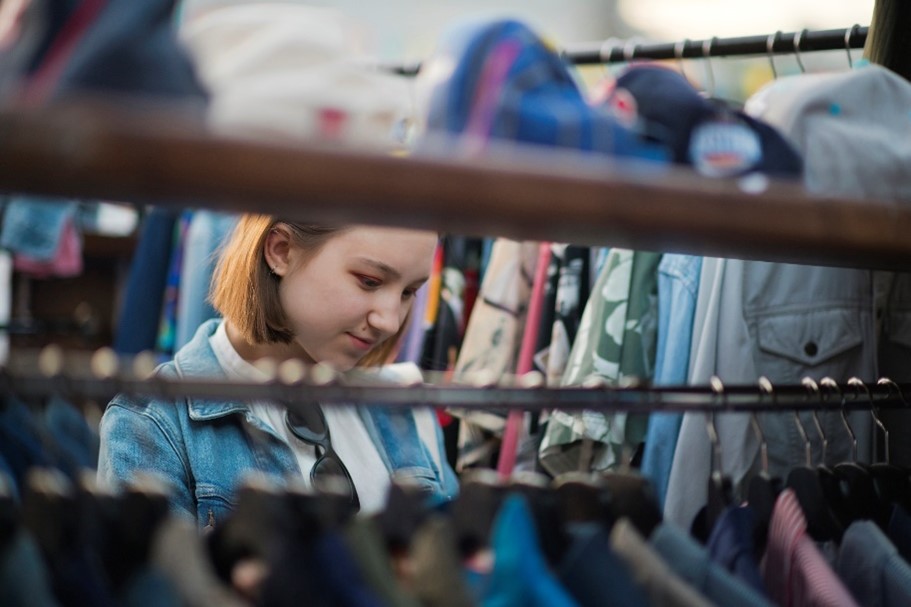 Then, smartphones and social media arrived and changed the face of commerce forever. Once you could order clothes online through Instagram and Facebook in 2016, fast fashion orders accelerated. As well as that, websites such as Pretty Little Thing, Shein, Missguided and Boohoo.com have become some of the trendiest fashion sites to order from today.
But what if you could remain fashionable while reducing your carbon footprint?
The Internet, while acting as an enabler for fast fashion, can also be a driving force for creating sustainable fashion choices. A notable example of this has been eBay, who have been around since 1995.
For years, eBay has been an accessible marketplace selling pre-loved goods of all sorts, with clothes included. This year, ITV’s Love Island, ended their collaboration with fast fashion company Pretty Little Thing as their fashion sponsor, and replaced them with eBay, recognising the impact the show can have on its impressionable audience.
eBay isn’t the only site dedicated to creating a circular economy. In 2016, Facebook launched Marketplace, which was established to be a direct competitor with eBay and US ad listing service, Craigslist. Facebook’s Marketplace enables people to advertise goods for sale or for free to their local community, which has proved to be a success, with over 1 billion monthly users.
Then, smartphones and social media arrived and changed the face of commerce forever. Once you could order clothes online through Instagram and Facebook in 2016, fast fashion orders accelerated. As well as that, websites such as Pretty Little Thing, Shein, Missguided and Boohoo.com have become some of the trendiest fashion sites to order from today.
But what if you could remain fashionable while reducing your carbon footprint?
The Internet, while acting as an enabler for fast fashion, can also be a driving force for creating sustainable fashion choices. A notable example of this has been eBay, who have been around since 1995.
For years, eBay has been an accessible marketplace selling pre-loved goods of all sorts, with clothes included. This year, ITV’s Love Island, ended their collaboration with fast fashion company Pretty Little Thing as their fashion sponsor, and replaced them with eBay, recognising the impact the show can have on its impressionable audience.
eBay isn’t the only site dedicated to creating a circular economy. In 2016, Facebook launched Marketplace, which was established to be a direct competitor with eBay and US ad listing service, Craigslist. Facebook’s Marketplace enables people to advertise goods for sale or for free to their local community, which has proved to be a success, with over 1 billion monthly users.
People’s perceptions towards fast fashion have changed in recent years. We are seeing more celebrities, influencers and young people opt to thrift clothes rather than support large fast fashion warehouses like Shein or Penney's.In the past, ‘thrifty’ was once a positive, rather than a negative comment, in any era when people valued the cost and effort which went into producing clothing.
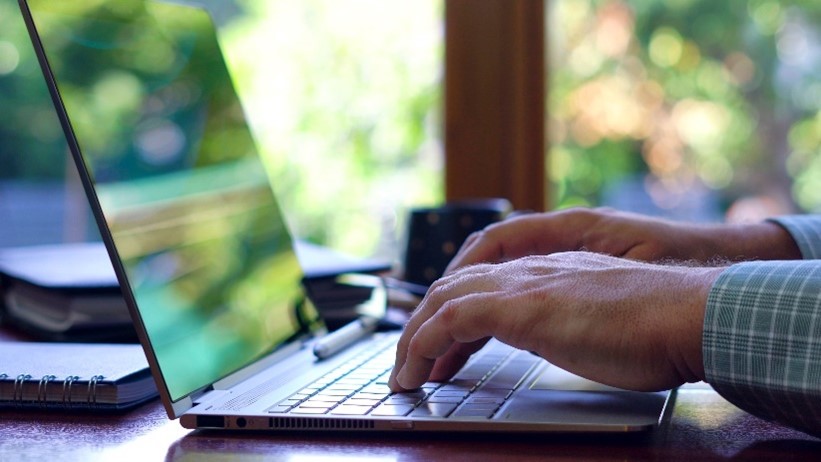 Thrifting is no longer confined to store-front shops. Some of the best goods can come from someone else’s wardrobe. In 2011, the concept drove the creation of Depop.
Depop was established in London, as a peer to peer, social e-commerce community, where you could “like” and buy directly from the seller. Depop has grown in popularity, especially among young people. As of 2021, Depop now has over 21 million users, 90% of which are under the age of 26.
Depop has proved that all you need to make more sustainable choices in fashion is a smartphone, a stable internet connection, and the drive to make some cash on your old clothes. Depop published its’ sustainability strategy in 2021, cementing its’ commitment to greener and more ethical commerce further (more here: Depop Sustainability Strategy ).
SIRO also published its first sustainability strategy in 2021 (more here: SIRO Sustainability Strategy ). Key aspects include switching our fleet to electric vehicles, reducing waste in the construction of our full fibre network, and commitments to promoting diversity and inclusive practices in the workplace.
With so many companies now pushing forward with sustainability commitments, it’s important to be conscious of greenwashing, including in the fashion industry. Buzzwords like “eco-friendly,” “biodegradable” and “carbon neutral” are thrown around regularly. So, it’s essential to do your research first, allowing you to shop with companies that have genuine sustainable policies and practices in place.
In the past, attitudes to clothing were different. The focus was on quality and durability vs. our current throwaway culture. ‘Thrifty’ was once a positive, rather than a negative comment, in any era when people valued the cost and effort which went into producing clothing. The circular economy (though not called that back then) was often in full swing with clothing passed down through the family or precious items like wedding dresses repurposed into garments such as communion or christening outfits.
Sustainable living provides an opportunity to rethink how we value clothing and to embrace being thrifty again. Technology and connectivity can now also make sustainable choices more accessible allowing consumers to shop in a more environmentally and socially equitable way.
A final thought, particularly as we grapple with cost-of-living challenges, is the opportunity to make money from your pre-loved clothing, by opting to download apps that offer resale services.
Technology, including fibre broadband, is driving the growth of the second-hand market across the globe. With SIRO’s 100% fibre to the premises broadband, you can manage your orders, post up your best pre-loved fashion outfits and make connections all from the comfort of your home.
Thrifting is no longer confined to store-front shops. Some of the best goods can come from someone else’s wardrobe. In 2011, the concept drove the creation of Depop.
Depop was established in London, as a peer to peer, social e-commerce community, where you could “like” and buy directly from the seller. Depop has grown in popularity, especially among young people. As of 2021, Depop now has over 21 million users, 90% of which are under the age of 26.
Depop has proved that all you need to make more sustainable choices in fashion is a smartphone, a stable internet connection, and the drive to make some cash on your old clothes. Depop published its’ sustainability strategy in 2021, cementing its’ commitment to greener and more ethical commerce further (more here: Depop Sustainability Strategy ).
SIRO also published its first sustainability strategy in 2021 (more here: SIRO Sustainability Strategy ). Key aspects include switching our fleet to electric vehicles, reducing waste in the construction of our full fibre network, and commitments to promoting diversity and inclusive practices in the workplace.
With so many companies now pushing forward with sustainability commitments, it’s important to be conscious of greenwashing, including in the fashion industry. Buzzwords like “eco-friendly,” “biodegradable” and “carbon neutral” are thrown around regularly. So, it’s essential to do your research first, allowing you to shop with companies that have genuine sustainable policies and practices in place.
In the past, attitudes to clothing were different. The focus was on quality and durability vs. our current throwaway culture. ‘Thrifty’ was once a positive, rather than a negative comment, in any era when people valued the cost and effort which went into producing clothing. The circular economy (though not called that back then) was often in full swing with clothing passed down through the family or precious items like wedding dresses repurposed into garments such as communion or christening outfits.
Sustainable living provides an opportunity to rethink how we value clothing and to embrace being thrifty again. Technology and connectivity can now also make sustainable choices more accessible allowing consumers to shop in a more environmentally and socially equitable way.
A final thought, particularly as we grapple with cost-of-living challenges, is the opportunity to make money from your pre-loved clothing, by opting to download apps that offer resale services.
Technology, including fibre broadband, is driving the growth of the second-hand market across the globe. With SIRO’s 100% fibre to the premises broadband, you can manage your orders, post up your best pre-loved fashion outfits and make connections all from the comfort of your home.
 SIRO’s Employee Experience Manager and Executive Assistant to the CEO (Chief Executive Officer), Gillian Quigley, explores digital wellbeing apps, mental health, and the importance of staying connected.
They say these days that there’s an app for everything. An app to order food or clothes, to stream your favourite shows, and even to adjust the temperature within your home. But what about an app to improve your mental health? General wellbeing and morale over the course of the past three years has naturally dipped because of strict restrictions, lockdowns and varying levels of anxiety within society. People yearned for diverse ways to connect when the effects of loneliness in Ireland was higher than ever before. 51% of people admitted that the pandemic influenced their mental health, with loneliness in Ireland doubling in 2021, as a result.
It’s completely understandable that people would begin to feel more anxious, depressed, isolated or even paranoid when uncertainty was the norm for so long. It’s not all bad, though. On the flip side, mental health awareness is at an all-time high. This is thanks in no small part to digital health and wellbeing apps gaining in popularity, due to increased awareness campaigns by health services and influencers. In a 2021 survey by St. Patricks Mental Health Hospital, 72% of those surveyed, believe Irish society is more open to talking about mental health issues since the onset of the pandemic.
Not only that, but health services have also transitioned their practices to digital platforms to improve accessibility for patients. As an Employee Experience Manager at SIRO, understanding what platforms can help your employee’s morale and general wellbeing is a key aspect of the job.
For employees in Ireland, there are many corporate and individual wellbeing platforms, promising a variety of outcomes, with most offering users free programmes through their apps that cover a wide range of health aspects. Meditation, emotional intelligence and wellbeing advice, yoga, and even financial support to name but a few.
Being able to manage your mental, physical, and emotional wellbeing in your own time, is one of the main reasons health apps have become so popular, especially as we shift into a hybrid, digital way of living. As well as that, it can make what is usually a daunting task easier to manage, as you dip in and out of these services, at times that work for you.
SIRO’s Employee Experience Manager and Executive Assistant to the CEO (Chief Executive Officer), Gillian Quigley, explores digital wellbeing apps, mental health, and the importance of staying connected.
They say these days that there’s an app for everything. An app to order food or clothes, to stream your favourite shows, and even to adjust the temperature within your home. But what about an app to improve your mental health? General wellbeing and morale over the course of the past three years has naturally dipped because of strict restrictions, lockdowns and varying levels of anxiety within society. People yearned for diverse ways to connect when the effects of loneliness in Ireland was higher than ever before. 51% of people admitted that the pandemic influenced their mental health, with loneliness in Ireland doubling in 2021, as a result.
It’s completely understandable that people would begin to feel more anxious, depressed, isolated or even paranoid when uncertainty was the norm for so long. It’s not all bad, though. On the flip side, mental health awareness is at an all-time high. This is thanks in no small part to digital health and wellbeing apps gaining in popularity, due to increased awareness campaigns by health services and influencers. In a 2021 survey by St. Patricks Mental Health Hospital, 72% of those surveyed, believe Irish society is more open to talking about mental health issues since the onset of the pandemic.
Not only that, but health services have also transitioned their practices to digital platforms to improve accessibility for patients. As an Employee Experience Manager at SIRO, understanding what platforms can help your employee’s morale and general wellbeing is a key aspect of the job.
For employees in Ireland, there are many corporate and individual wellbeing platforms, promising a variety of outcomes, with most offering users free programmes through their apps that cover a wide range of health aspects. Meditation, emotional intelligence and wellbeing advice, yoga, and even financial support to name but a few.
Being able to manage your mental, physical, and emotional wellbeing in your own time, is one of the main reasons health apps have become so popular, especially as we shift into a hybrid, digital way of living. As well as that, it can make what is usually a daunting task easier to manage, as you dip in and out of these services, at times that work for you.
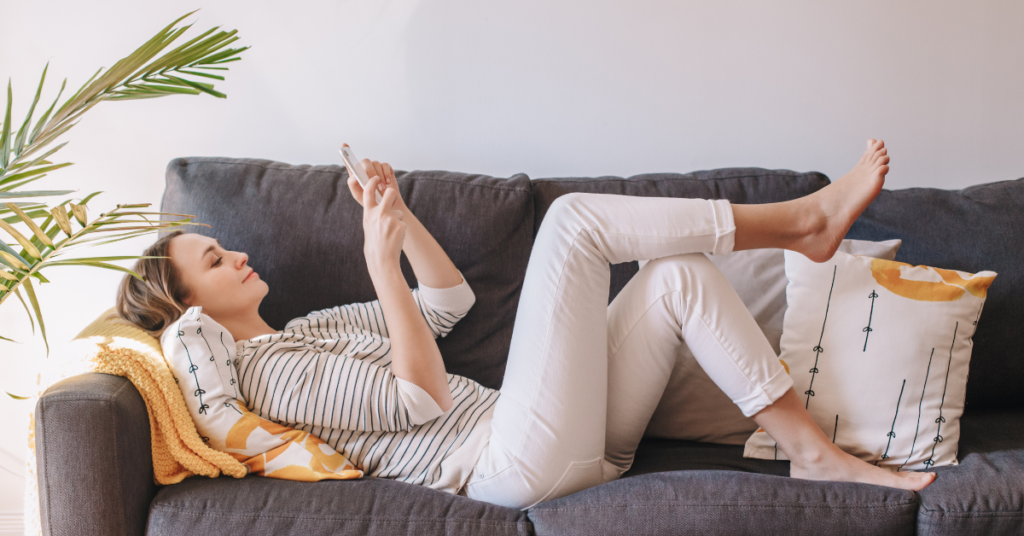 SIRO, like other companies provide apps to augment our support resources. However, you may choose to research, evaluate and use your own preferred option. There are many popular and affordable apps that don’t require intervention from your workplace. Some of these apps include , Calm, and Mood Tracker. These platforms allow you to track their moods to identify potentially harmful patterns, allowing them to gain general perspective, combat anxieties and practice mindfulness through meditation or mindfulness.
Personally, I use physical wellbeing apps and YouTube channels to help with my mental and physical health – I find exercise a terrific way to alleviate stress and find time for my thoughts. Fitness apps can empower people to take their health into their own hands, and the same can be applied to mental and spiritual health.
It’s important to emphasise that digital wellbeing and health apps are not just a temporary fix for use during the pandemic, but something that will be become a staple for the future.
SIRO, like other companies provide apps to augment our support resources. However, you may choose to research, evaluate and use your own preferred option. There are many popular and affordable apps that don’t require intervention from your workplace. Some of these apps include , Calm, and Mood Tracker. These platforms allow you to track their moods to identify potentially harmful patterns, allowing them to gain general perspective, combat anxieties and practice mindfulness through meditation or mindfulness.
Personally, I use physical wellbeing apps and YouTube channels to help with my mental and physical health – I find exercise a terrific way to alleviate stress and find time for my thoughts. Fitness apps can empower people to take their health into their own hands, and the same can be applied to mental and spiritual health.
It’s important to emphasise that digital wellbeing and health apps are not just a temporary fix for use during the pandemic, but something that will be become a staple for the future.
 In acknowledging that digital wellbeing apps are a natural progression for health services, with more services coming online each day, it’s important to ensure that your home or business is prepared for this evolution. SIRO’s fibre to the premises broadband is a ‘one size fits all’ type of connectivity that’s resilient enough to handle any video calls, heavy data uploads without a break in signal, when using cloud-based health platforms.
The pandemic has shown us that connectivity matters now, more than ever before. Staying connected with your friends, family and your own self is vital to having a positive, healthy state of mind.
If you or someone you know are experiencing mental health issues, please contact: www.samaritans.org or 116 123.
In acknowledging that digital wellbeing apps are a natural progression for health services, with more services coming online each day, it’s important to ensure that your home or business is prepared for this evolution. SIRO’s fibre to the premises broadband is a ‘one size fits all’ type of connectivity that’s resilient enough to handle any video calls, heavy data uploads without a break in signal, when using cloud-based health platforms.
The pandemic has shown us that connectivity matters now, more than ever before. Staying connected with your friends, family and your own self is vital to having a positive, healthy state of mind.
If you or someone you know are experiencing mental health issues, please contact: www.samaritans.org or 116 123.
SIRO, the broadband network operator, has today launched its’ 100% fibre broadband network in Ballina. SIRO’s broadband network will see the company bring its’ world class connectivity to more than 3,500 premises in the town, with a €4 million investment in this essential infrastructure.
SIRO’s broadband network for Ballina was officially launched by Ballina Cathaoirleach Councillor Mark Duffy, at an event in The Great National Hotel this morning.
Today’s launch in Ballina follows on from SIRO’s October 2021 announcement, where SIRO outlined its plans to connect 90 additional towns and 770,000 premises across Ireland with its’ Fibre-To-The-Premise broadband by 2026. The company’s total investment in broadband infrastructure across Irish towns will exceed €1 billion to deliver its’ future-proofed, sustainable broadband infrastructure.
SIRO is a joint venture broadband company between ESB and Vodafone. Since its’ establishment in 2015, SIRO, has to date, rolled out its network to 65 towns across Ireland, reaching more than 430,000 homes and businesses and almost one million people.
Across Mayo and the West, SIRO has already connected tens of thousands of homes and businesses in Castlebar, Westport, Galway, and Sligo to its network. Ballina will be the latest Mayo town to receive its 100% fibre broadband. Consumers and businesses will be able to order SIRO’s broadband from September, with network roll out expected to be completed by the end of this year.
The first areas in Ballina that can avail of up to 2 gigabits per second broadband include: Cluain Na Rí, The Spires, Robin Hill, Church Manor, Healy Terrace, Oakwood Drive and Brae View.
SIRO’s state-of-the-art fibre broadband network is built on the ESB electricity infrastructure, trusted for its’ reliability and resilience. Richard Nolan and CBE are the contractors on the ground in Ballina working with SIRO to ‘light up’ the town with high-speed fibre broadband.
Speaking at the launch, SIRO CEO, John Keaney said: “High quality connectivity is a key enabler for economic growth, and particularly for regional towns like Ballina. The pandemic proved that work from anywhere, once there is access to reliable and future proofed broadband, is now possible. Access to high-quality connectivity is a game changer which allows regional towns to compete on an equal footing with our cities for inward investment and job creation. It’s also an important service to have available for tourists and visitors to Ballina. Since 2015, SIRO has worked to bring world-class fibre connectivity to the heart of towns across Ireland. Our objective is to ensure our fibre broadband empowers people to work and live how and where they want and businesses to access the connectivity needed to operate with ease and efficiency. We are pleased to be extending our footprint further today, by adding over 3,500 Ballina premises to our network, in addition to our existing presence in Westport and Castlebar” added Mr. Keaney.Present at the launch, Ballina Cathaoirleach Councillor Mark Duffy added: “Over the last number of years, Ballina has benefitted hugely as people have migrated West, either moving back home and/or leaving cities for a better quality of life. Investment in fibre broadband, like SIRO’s full fibre network, will keep them in Ballina. SIRO’s network and investment helps Ballina realise its’ full potential allowing people to stay connected and ensuring they can live, work and visit the town”. SIRO’s broadband network is currently available to 430,000 homes and businesses, growing to 770,000 over the next four years. SIRO as an open access wholesaler, partners with 19 broadband retailers across Ireland, to ensure that customers and businesses enjoy greater choice and competition. Retailers available in Ballina will be: Digiweb, Sky, Vodafone, Fastcom, PureTelecom, Westnet, and Viatel. First homes and premises will be live in September. To keep up to date with our rollout plans and to be notified when your home or business in Ballina is SIRO ready, register-your-interest today.
 The concept of smart homes has been growing in popularity in recent years, with homeowners and new buyers wishing to modernise and update their homes. Findings from recent research commissioned by SIRO showed that 73% of respondents would consider themselves well informed or informed on smart homes. A smart home, in simple terms, is a home equipped with lighting, heating, and electronic devices that can be controlled remotely by smartphone or computer.
Other key findings in SIRO’s recent research on smart homes included the widespread adoption of smart devices in Irish households:
The concept of smart homes has been growing in popularity in recent years, with homeowners and new buyers wishing to modernise and update their homes. Findings from recent research commissioned by SIRO showed that 73% of respondents would consider themselves well informed or informed on smart homes. A smart home, in simple terms, is a home equipped with lighting, heating, and electronic devices that can be controlled remotely by smartphone or computer.
Other key findings in SIRO’s recent research on smart homes included the widespread adoption of smart devices in Irish households:
- Almost seven out of ten (67%) consumers own a smart TV;
- Just under half (49%) of households are in possession of a virtual assistant technology like Alexa;
- A third use smart home technology like digital heating controls and lighting; and
- A quarter use security devices like video doorbells.
 Sustainability
Consumers are far more environmentally conscious nowadays, looking to purchase a product or service that is sustainable. The same goes with buying a home.
Again, smart tech can make home living more sustainable (and more affordable). Lights can be controlled to be turned on and off at various times with the use of Smart LED bulbs, saving energy. Smart showers are another example, that will soon become the norm in our bathrooms. These, not only help conserve water by allowing you to set a limit on the duration of shower, but they can also create the ideal shower experience, depending on personal preferences. You can adjust the temperature, flow of water and more all via a mobile device or voice control.
Sustainability
Consumers are far more environmentally conscious nowadays, looking to purchase a product or service that is sustainable. The same goes with buying a home.
Again, smart tech can make home living more sustainable (and more affordable). Lights can be controlled to be turned on and off at various times with the use of Smart LED bulbs, saving energy. Smart showers are another example, that will soon become the norm in our bathrooms. These, not only help conserve water by allowing you to set a limit on the duration of shower, but they can also create the ideal shower experience, depending on personal preferences. You can adjust the temperature, flow of water and more all via a mobile device or voice control.

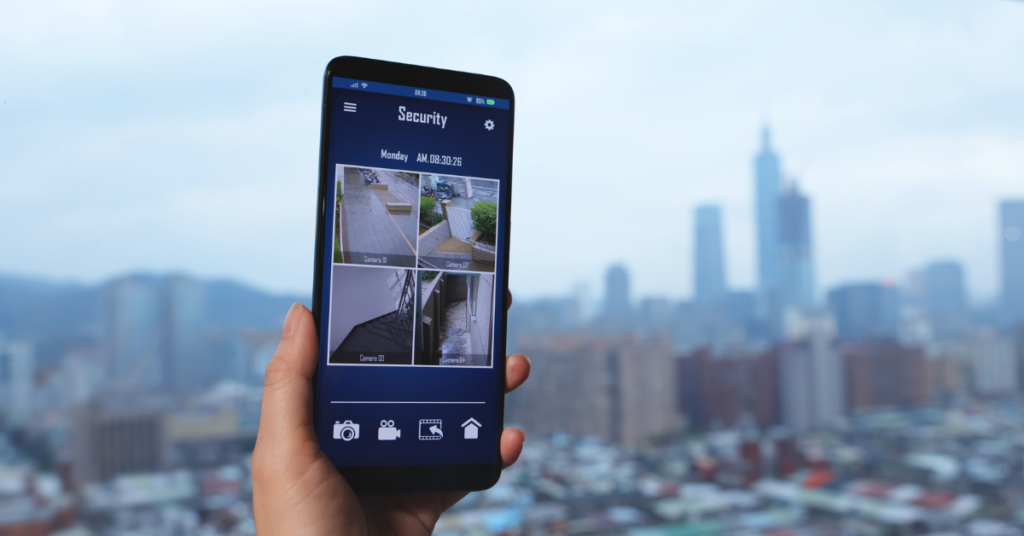 The prevalence of smart home tech runs parallel to increasing access to fast and reliable fibre broadband, particularly, the rapidly improving in-home Wi-Fi experience. With one linked to the other, its’ no surprise that as our connectivity continues to be enhanced in the home, the upward trajectory of smart home technology will closely follow.
To find out if SIRO 100% fibre broadband is available to our home, search your eircode today.
The prevalence of smart home tech runs parallel to increasing access to fast and reliable fibre broadband, particularly, the rapidly improving in-home Wi-Fi experience. With one linked to the other, its’ no surprise that as our connectivity continues to be enhanced in the home, the upward trajectory of smart home technology will closely follow.
To find out if SIRO 100% fibre broadband is available to our home, search your eircode today.
SIRO, the fibre broadband wholesaler and joint venture between ESB and Vodafone, today launched a new €4 million fibre broadband network in Longford town. SIRO’s network roll-out will make high speed, reliable fibre broadband available to more than more than 4,000 premises in the town.
The network was officially launched by Minister for State for Local Government and Planning, and Longford-Westmeath TD, Peter Burke in the Longford Arms Hotel.
The announcement follows on from SIRO’s launch of their national network expansion in October 2021, where the company confirmed that a further 90 new towns, including Longford town, would receive its’ 100% fibre-to-the-premises broadband.
This is in addition to the existing 64 towns already connected to SIRO’s network, including the midland towns of Mullingar, Athlone and Portlaoise. Currently, SIRO’s broadband network is available to 430, 000 homes and businesses, growing to 770,000 over the next four years.
SIRO’s state-of-the-art fibre broadband network is built on the ESB electricity infrastructure, trusted for its’ reliability and resilience.
3,000 premises in Longford town can avail of SIRO’s fibre broadband network by the end of 2022, with the network to reach over 4,000. SIRO’s overall investment in Longford town will represents a €4 million by the company. TLI is the contractor on the ground in Longford working with SIRO to ‘light up’ the town with high-speed fibre broadband.
Some of the first areas in Longford town that can avail of SIRO’s gigabit broadband are Dublin Street, Chapel Lane, Ballymahon Street, College Park, Canal Close, Harbour View, Fairgreen View, Farneyhoogan, Railway Meadow, and Western Park.
Having a reliable internet connection is now an essential utility, as important electricity or gas. Research commissioned by SIRO earlier this year found that connectivity is also a key consideration when people are choosing where to live. The research found that 53% of under 35’s rank broadband as the most important factor when choosing a home.
SIRO’s fibre connectivity is the last connection a home or business in Longford town will ever need, as its gigabit speeds are scalable and future-proofed for future demand – up to 25 Gigabits.
SIRO as an open access wholesaler, partners with 19 broadband retailers across Ireland, to ensure that customers and businesses enjoy greater choice and competition.
CEO of SIRO John Keaney, commented: “Connectivity is an enabler of growth for communities and towns within Ireland, and we are delighted to provide Longford town with a robust, reliable connection that can serve the people and businesses of the town for years to come. Since the pandemic, people have begun to recognise the value that a dependable, fibre connection can add to one’s way of life or business. With SIRO’s gigabit broadband, you can work anytime, and anywhere, stay connected to family and friends or live stream videos or gaming without any lag or downtime. More than 4,000 homes and businesses in Longford town will be able to access SIRO’s fibre broadband network, giving these premises a 100% fibre connection, which supports working from home and more lived-in, sustainable communities vs. commuter towns. SIRO’s fibre broadband will also attract further investment to the town and support local business to grow and develop particularly through greater use of digital technologies.”
Minister of State for Planning and Government Peter Burke and TD for Longford-Westmeath stated: “This investment represents a significant gain for the people and businesses of Longford who can now access 100% fibre to meet the immense demand we all have for connectivity these days, whether this is for educational, leisure or business purposes. It is a key commitment of this Government to achieve balanced regional development with emphasis on growth outside of Dublin. High-speed broadband facilitated by SIRO will enable Longford businesses to maintain a level playing field and will act as another great reason to attract jobs and opportunities to Longford and the wider Midlands region. I congratulate SIRO on their expansion and look forward to seeing more and more locals reap the benefits of this fantastic service”
To keep up to date with our rollout plans and to be notified when your home or business in Longford is SIRO ready, register-your-interest today.
New research about attitudes to smart homes and technology commissioned by SIRO, the wholesale broadband operator delivering a Gigabit broadband network to 770,000 homes and businesses across the country, has found that almost two thirds (63%) of respondents believe that the energy saving and environmentally friendly benefits are the most important factors of smart homes. Just over half (54%) of the survey participants stated that smart devices have helped them save money.
In the midst of rising energy costs, the technology is particularly appealing to over 55s. The research revealed that that demographic is most aware (72%) of the energy saving and environmentally friendly benefits of smart homes. 61% of over 55s also stated that the technology has helped them to lower costs, higher than any other age cohort.
The research also revealed that high quality broadband is the most important factor for under 35s when considering their ideal home. Just over half of those aged under 35 (53%) surveyed singled out broadband as the deciding factor when purchasing a home, compared to the overall choice of the general public who placed a greater emphasis (40%) on a garden. Changing consumer habits and trends such as the shift to remote working and a fall in car ownership were evident from the research as factors like having a parking spot at their home (15%) ranked lower on the list.
In the wake of the pandemic, a greater appreciation for high-speed quality broadband was also evident with 4 in 5 (84%) members of the general public flagging their support for a change in the Irish law to make it a requirement that developers must install high speed broadband and infrastructure when constructing all new homes.
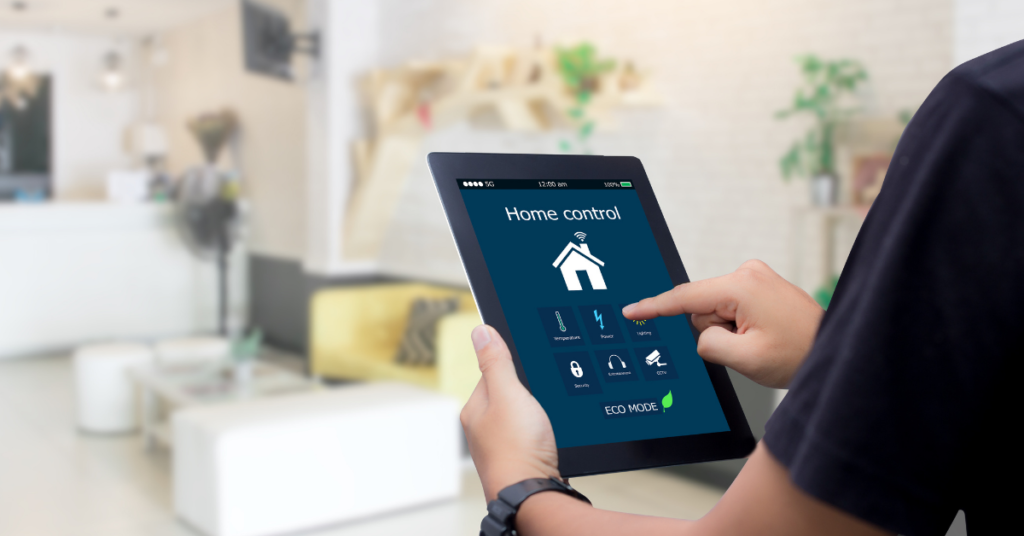 The research also revealed the widespread adoption of smart devices in Irish households. Almost seven out of ten (67%) consumers own a Smart TV; with just under half (49%) of households in possession of a virtual assistant technology like Alexa; a third of the public using smart home technology like digital heating controls and lighting; and a quarter using security devices like video doorbells.
Noting the research findings, SIRO Head of Operations and New Developments Cian O’Mahony said, “At SIRO, through our work with developers to bring our high-quality fibre broadband to new developments, we see the huge appetite amongst the public for homes with smart and connected devices. Equally retrofitting existing homes with smart technology is a growing trend. Today’s research brings to life the reasons people are opting for smart home technology. These can vary depending on life stages. Those in the older age demographics are more likely to view smart homes as important for environmental reasons, with younger groups valuing the convenience that they provide.
Commenting on the sustainability advantages, SIRO Director of Corporate Affairs Amanda Glancy said,“Smart home devices deliver numerous benefits. More sustainable living, achieving climate change targets, enhanced security or savings on energy or heating bills are key attributes. The latter is very top of mind given the steep increases in energy prices. As fibre broadband networks continue to roll-out across Ireland, this research indicates more individuals, families and communities will take advantage of the benefits of smart homes, particularly for environmental benefits and reducing the cost of living.”
Research conducted by Amárach Research, surveyed 1,585 people in Ireland at the end of January 2022. Amárach Research undertook this piece of research among a nationally representative sample of respondents (age, gender, region and social class) on awareness of and attitudes to Smart Homes.
Head of Operations, Cian O' Mahony will be speaking at the IHBA Summit tomorrow, April 5th in Croke Park on Broadband and Housing Construction.
The research also revealed the widespread adoption of smart devices in Irish households. Almost seven out of ten (67%) consumers own a Smart TV; with just under half (49%) of households in possession of a virtual assistant technology like Alexa; a third of the public using smart home technology like digital heating controls and lighting; and a quarter using security devices like video doorbells.
Noting the research findings, SIRO Head of Operations and New Developments Cian O’Mahony said, “At SIRO, through our work with developers to bring our high-quality fibre broadband to new developments, we see the huge appetite amongst the public for homes with smart and connected devices. Equally retrofitting existing homes with smart technology is a growing trend. Today’s research brings to life the reasons people are opting for smart home technology. These can vary depending on life stages. Those in the older age demographics are more likely to view smart homes as important for environmental reasons, with younger groups valuing the convenience that they provide.
Commenting on the sustainability advantages, SIRO Director of Corporate Affairs Amanda Glancy said,“Smart home devices deliver numerous benefits. More sustainable living, achieving climate change targets, enhanced security or savings on energy or heating bills are key attributes. The latter is very top of mind given the steep increases in energy prices. As fibre broadband networks continue to roll-out across Ireland, this research indicates more individuals, families and communities will take advantage of the benefits of smart homes, particularly for environmental benefits and reducing the cost of living.”
Research conducted by Amárach Research, surveyed 1,585 people in Ireland at the end of January 2022. Amárach Research undertook this piece of research among a nationally representative sample of respondents (age, gender, region and social class) on awareness of and attitudes to Smart Homes.
Head of Operations, Cian O' Mahony will be speaking at the IHBA Summit tomorrow, April 5th in Croke Park on Broadband and Housing Construction.
 The research also revealed the widespread adoption of smart devices in Irish households. Almost seven out of ten (67%) consumers own a Smart TV; with just under half (49%) of households in possession of a virtual assistant technology like Alexa; a third of the public using smart home technology like digital heating controls and lighting; and a quarter using security devices like video doorbells.
Noting the research findings, SIRO Head of Operations and New Developments Cian O’Mahony said, “At SIRO, through our work with developers to bring our high-quality fibre broadband to new developments, we see the huge appetite amongst the public for homes with smart and connected devices. Equally retrofitting existing homes with smart technology is a growing trend. Today’s research brings to life the reasons people are opting for smart home technology. These can vary depending on life stages. Those in the older age demographics are more likely to view smart homes as important for environmental reasons, with younger groups valuing the convenience that they provide.
Commenting on the sustainability advantages, SIRO Director of Corporate Affairs Amanda Glancy said,“Smart home devices deliver numerous benefits. More sustainable living, achieving climate change targets, enhanced security or savings on energy or heating bills are key attributes. The latter is very top of mind given the steep increases in energy prices. As fibre broadband networks continue to roll-out across Ireland, this research indicates more individuals, families and communities will take advantage of the benefits of smart homes, particularly for environmental benefits and reducing the cost of living.”
Research conducted by Amárach Research, surveyed 1,585 people in Ireland at the end of January 2022. Amárach Research undertook this piece of research among a nationally representative sample of respondents (age, gender, region and social class) on awareness of and attitudes to Smart Homes.
Head of Operations, Cian O' Mahony will be speaking at the IHBA Summit tomorrow, April 5th in Croke Park on Broadband and Housing Construction.
The research also revealed the widespread adoption of smart devices in Irish households. Almost seven out of ten (67%) consumers own a Smart TV; with just under half (49%) of households in possession of a virtual assistant technology like Alexa; a third of the public using smart home technology like digital heating controls and lighting; and a quarter using security devices like video doorbells.
Noting the research findings, SIRO Head of Operations and New Developments Cian O’Mahony said, “At SIRO, through our work with developers to bring our high-quality fibre broadband to new developments, we see the huge appetite amongst the public for homes with smart and connected devices. Equally retrofitting existing homes with smart technology is a growing trend. Today’s research brings to life the reasons people are opting for smart home technology. These can vary depending on life stages. Those in the older age demographics are more likely to view smart homes as important for environmental reasons, with younger groups valuing the convenience that they provide.
Commenting on the sustainability advantages, SIRO Director of Corporate Affairs Amanda Glancy said,“Smart home devices deliver numerous benefits. More sustainable living, achieving climate change targets, enhanced security or savings on energy or heating bills are key attributes. The latter is very top of mind given the steep increases in energy prices. As fibre broadband networks continue to roll-out across Ireland, this research indicates more individuals, families and communities will take advantage of the benefits of smart homes, particularly for environmental benefits and reducing the cost of living.”
Research conducted by Amárach Research, surveyed 1,585 people in Ireland at the end of January 2022. Amárach Research undertook this piece of research among a nationally representative sample of respondents (age, gender, region and social class) on awareness of and attitudes to Smart Homes.
Head of Operations, Cian O' Mahony will be speaking at the IHBA Summit tomorrow, April 5th in Croke Park on Broadband and Housing Construction.  January is the time of the year we set (or reset) new personal fitness goals.
COVID-19 has changed the way people work-out or exercise. Lockdowns where gyms and other sporting facilities closed or a reluctance to undertake group sports with increased risk of contracting the virus both altered behaviours. But COVID-19 also accelerated changes already underway. Health and fitness are increasingly migrating online; with the art of exercise becoming ever more digitised and by extension personalised.
Significant improvements in connectivity, underpinned by access to high quality broadband such as SIRO’s fibre broadband network, are also driving the trend. Digital fitness is a huge and growing industry, with companies all trying to bring the next FitTech innovation to this multi-billion market.
January is the time of the year we set (or reset) new personal fitness goals.
COVID-19 has changed the way people work-out or exercise. Lockdowns where gyms and other sporting facilities closed or a reluctance to undertake group sports with increased risk of contracting the virus both altered behaviours. But COVID-19 also accelerated changes already underway. Health and fitness are increasingly migrating online; with the art of exercise becoming ever more digitised and by extension personalised.
Significant improvements in connectivity, underpinned by access to high quality broadband such as SIRO’s fibre broadband network, are also driving the trend. Digital fitness is a huge and growing industry, with companies all trying to bring the next FitTech innovation to this multi-billion market.
[caption id="attachment_7283" align="aligncenter" width="1024"]Last week’s annual Consumer Electronics Show, billed as the “most influential tech event in the world,” saw health and fitness technology take centre stage, with a vast range of FitTech apps and devices from global players represented.
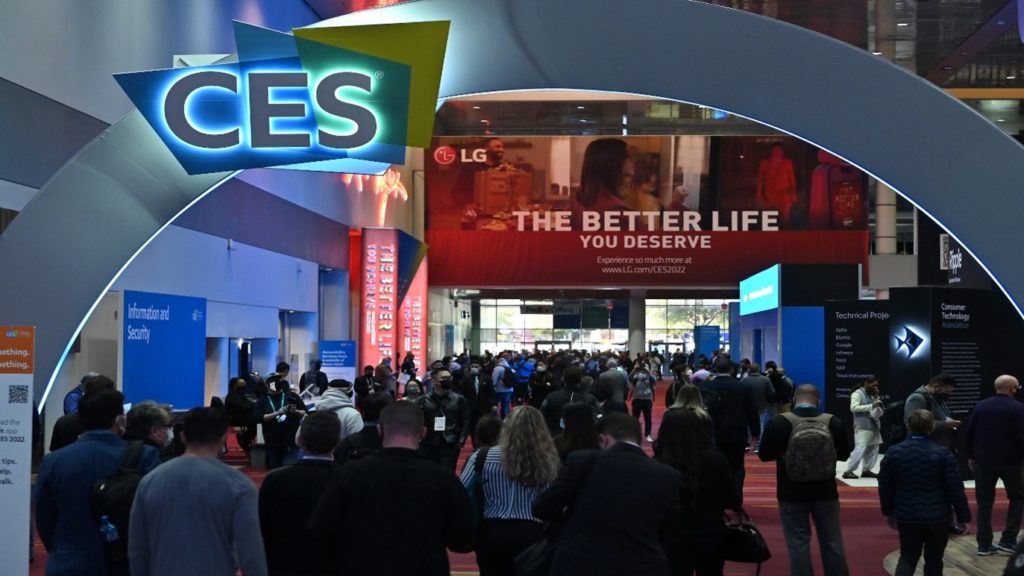 Image by Consumer Electronics Show[/caption]
Irish tech companies are also active in developing both FitTech products and services. Companies such as Glofox (a gym management app solution, which supported gyms in moving online during the pandemic) or Kitman Labs an industry leading sports analytics company, using artificial intelligence to increase athlete performance and health, just two leading examples.
At an individual level, what are the key digital fitness trends we can expect to see in 2022?
Image by Consumer Electronics Show[/caption]
Irish tech companies are also active in developing both FitTech products and services. Companies such as Glofox (a gym management app solution, which supported gyms in moving online during the pandemic) or Kitman Labs an industry leading sports analytics company, using artificial intelligence to increase athlete performance and health, just two leading examples.
At an individual level, what are the key digital fitness trends we can expect to see in 2022?
Key Online Fitness Trends for 2022
Online Workout with Personal Trainers
For many, one of the memories of the early days of COVID-19 in 2020, will be work-outs with Joe Wicks, aka The Body Coach. This trend of bringing the online gym class and/or the personal trainer into your front room looks set to continue into 2022. The availability of free workouts on platforms like YouTube has also made these workouts more accessible. Research has even shown that working out online with others motivates people to exercise for longer and with greater intensity.Hybrid Gym Memberships
The growth of at home online workouts doesn’t mean the end of the traditional gym membership. Like working from home, most people want a blend of online fitness and in-person gym experiences. The fitness industry has responded too. Increasingly, gyms are offering hybrid memberships providing the option of using their facilities in-person and taking a class or a work-out online.Ever More Personalised Wellness-Tracking Wearables
Wearable trackers measuring how far and fast we run, or walk have been part of the fitness landscape for years. In 2022 this technology looks set to delve much further looking at our overall health and fitness to include body temperatures, blood pressure, stress levels, sleep, and heart rate. Their form is changing too – moving beyond traditional wrist devices such as a smart watch. Think skin patches, rings and smart socks as the next generation of wearables. And it’s not just humans, a tracking collar for pets is on the way!Gamification of Fitness
Gamifying workouts means using gaming apps that allow you to play games during exercise. You can compete against yourself or others in competitions, achieve goals set by you or a team you've joined or track and connect with friends also using the App. Adopting a gaming approach to exercise makes it much more fun and engaging, even for the most exercise averse. Looking for a recommendation? Have you tried Zombies Run?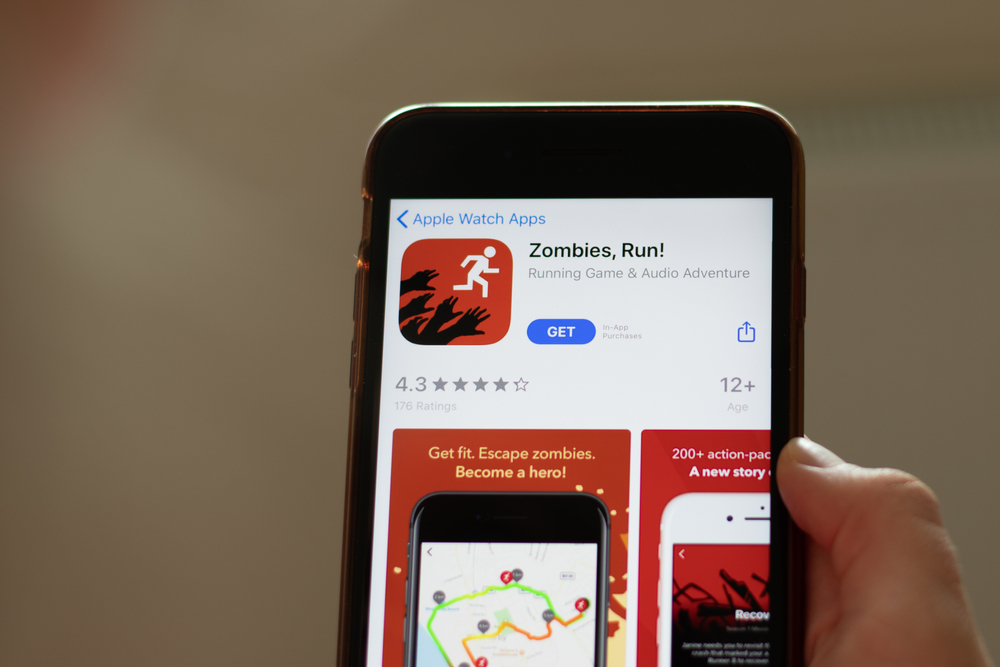
Smart Home Gym Equipment
Connected home gym equipment was popular, pre-pandemic, but has now really exploded. Smart fitness equipment allows for a whole other level of interactivity than their non-connected equivalents. Most offer a range of guided classes with instructors and/or individualised workouts based on your goals and current fitness level. Popular brands include the Peloton bike or the NordicTrack thread mills and rowing machines. Other innovations growing in popularity include Mirror, a wall-mounted device that guides users through a variety of high-intensity cardio classes and other exercises. And finally….The Weighted Hula Hoop
In the perfect marriage of online and social media meets fitness, the weighted hula hoop became the fitness phenomenon of 2021. First emerging on Tik Tok, with 200 million views under the #weightedhulahoop, these versions can be up to 3kg in weight and aim to improve body muscles and enhance heart health. Featuring on key influencers’ posts, the trend is set to grow in 2022.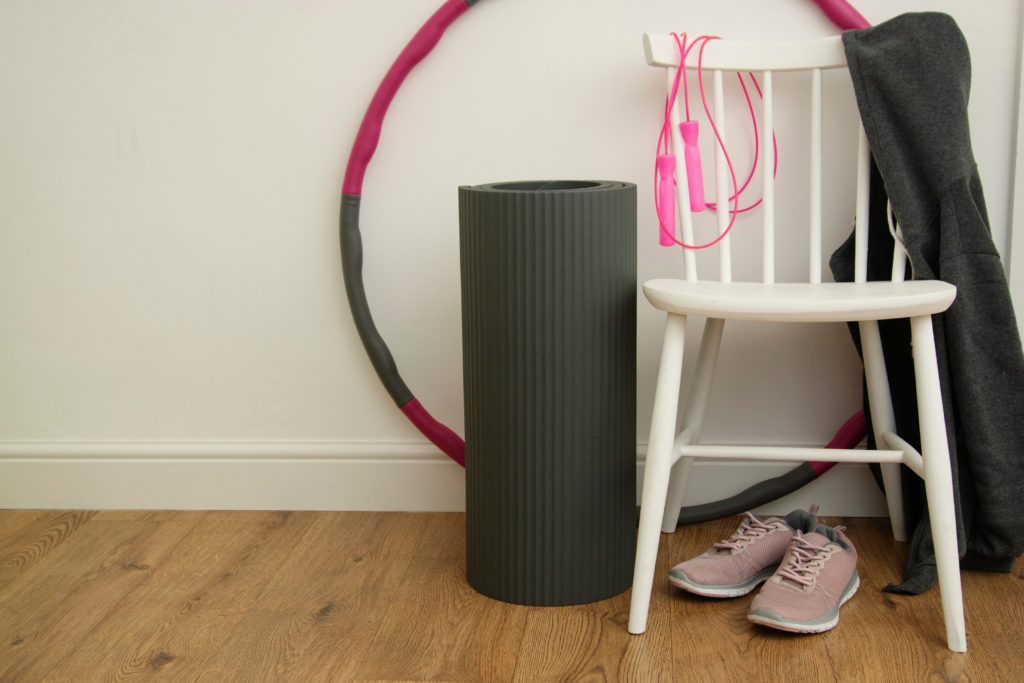
The Christmas and New Year holiday season is always the busiest time for broadband networks – 2021 was no exception. While many of us switched off our work laptops Christmas Eve, we typically turned to other devices in the home such as smart televisions, gaming consoles and smart phones, all of which depend on a strong broadband connection.
As expected, there was a significant increase in demand over the holiday period. A new all-time high occurred on the 25th December 2021, just shy of 3 Petabytes was downloaded on the SIRO network – That’s 3,000,000 Gigabytes.
[caption id="attachment_7272" align="aligncenter" width="1024"]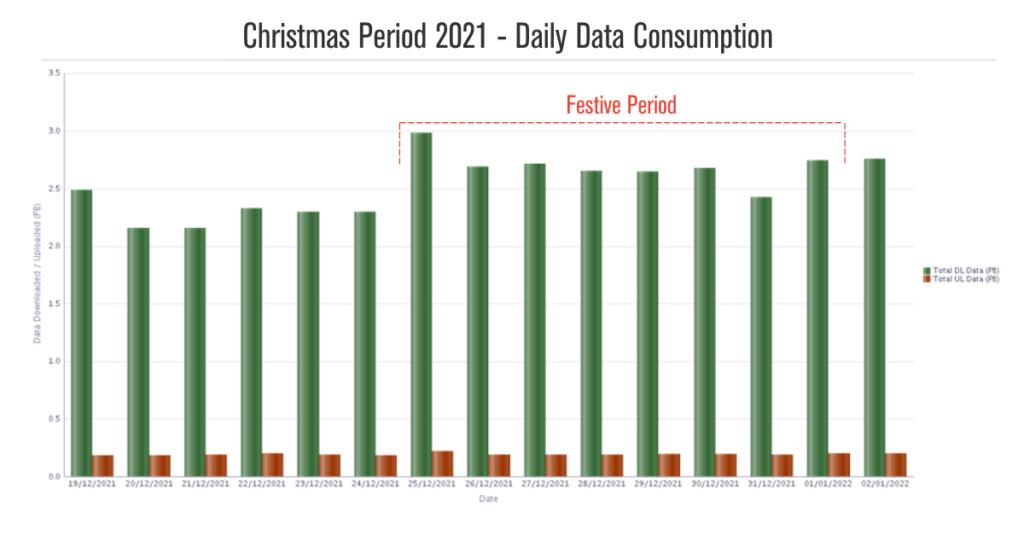 Christmas Period 2021 - Daily Data Consumption[/caption]
On a typical day, we would see activity on the network increasing from around 8am as people across Ireland start to wake up and begin using their devices. Data Usage usually peaks from 6pm as households settle in for the evening, watching Netflix across multiple devices, turning on the Playstation for a game of Fifa, or catching up on the day’s events via social media.
[caption id="attachment_7274" align="aligncenter" width="969"]
Christmas Period 2021 - Daily Data Consumption[/caption]
On a typical day, we would see activity on the network increasing from around 8am as people across Ireland start to wake up and begin using their devices. Data Usage usually peaks from 6pm as households settle in for the evening, watching Netflix across multiple devices, turning on the Playstation for a game of Fifa, or catching up on the day’s events via social media.
[caption id="attachment_7274" align="aligncenter" width="969"]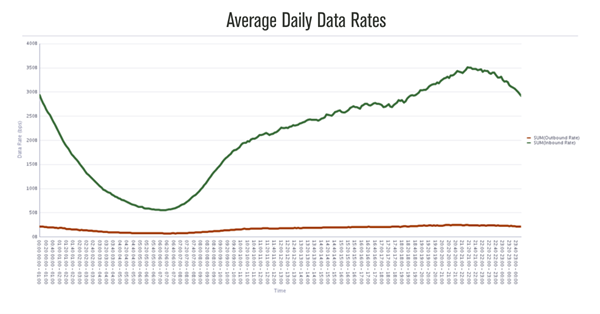 Average Daily Data Rate[/caption]
On Christmas Day however, we observed a significantly large ramp up in data demand between the hours of 7.00am to 10.00am. Such usage would not normally be reached until the late afternoon of a normal day. One potential reason is the strong demand for gaming console updates. PlayStations and Xboxes were at the top of Santa’s list this Christmas and sometimes Santa is careless, leaving this for parents to do early on Christmas morning.
We observed high usage maintained throughout the day, with some unusual spikey usage patterns emerging as people put their devices down to enjoy Christmas dinner.
[caption id="attachment_7273" align="aligncenter" width="1024"]
Average Daily Data Rate[/caption]
On Christmas Day however, we observed a significantly large ramp up in data demand between the hours of 7.00am to 10.00am. Such usage would not normally be reached until the late afternoon of a normal day. One potential reason is the strong demand for gaming console updates. PlayStations and Xboxes were at the top of Santa’s list this Christmas and sometimes Santa is careless, leaving this for parents to do early on Christmas morning.
We observed high usage maintained throughout the day, with some unusual spikey usage patterns emerging as people put their devices down to enjoy Christmas dinner.
[caption id="attachment_7273" align="aligncenter" width="1024"]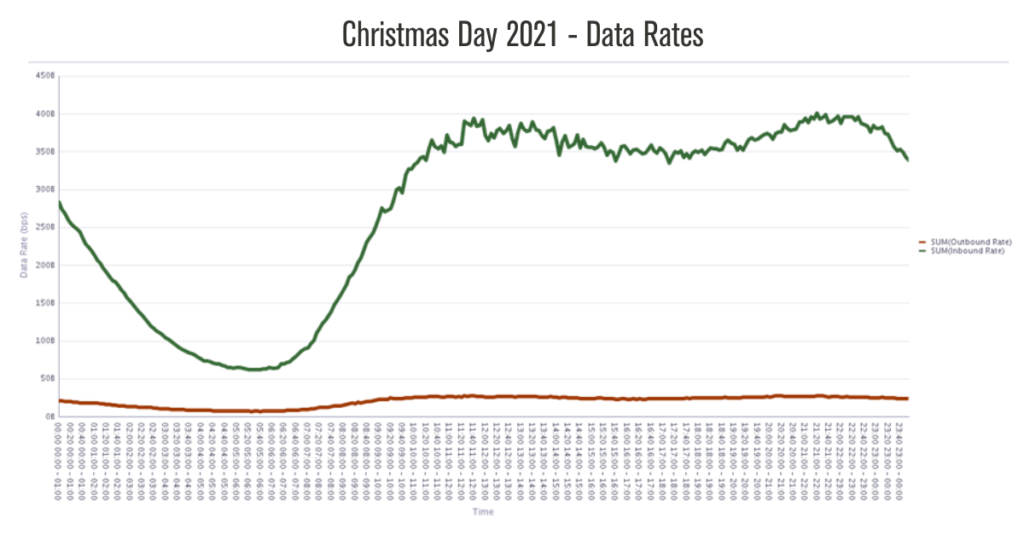 Christmas Day 2021 Data Rates[/caption]
2021 might not have been the ideal Christmas holiday, but having strong, reliable broadband truly enabled us to spend some much-needed quality time with our families, whether they are by our side, isolating or at the other side of the world.
Let us remember the people behind the network, the men and women who spend months and years planning, designing, building and installing the gold-standard fibre broadband to more than 100,000 Irish homes, and have continued to do so during the pandemic.
As we begin 2022, many of us will continue to work from home. Ensure that you have a broadband connection that you can rely on by switching to SIRO 100% fibre broadband. Our network easily supported updating of hundreds of gaming consoles at the same time on Christmas morning, and we will continue to support Irish homes for all your remote working, studying and entertaining needs in 2022.
Christmas Day 2021 Data Rates[/caption]
2021 might not have been the ideal Christmas holiday, but having strong, reliable broadband truly enabled us to spend some much-needed quality time with our families, whether they are by our side, isolating or at the other side of the world.
Let us remember the people behind the network, the men and women who spend months and years planning, designing, building and installing the gold-standard fibre broadband to more than 100,000 Irish homes, and have continued to do so during the pandemic.
As we begin 2022, many of us will continue to work from home. Ensure that you have a broadband connection that you can rely on by switching to SIRO 100% fibre broadband. Our network easily supported updating of hundreds of gaming consoles at the same time on Christmas morning, and we will continue to support Irish homes for all your remote working, studying and entertaining needs in 2022.
 Christmas Period 2021 - Daily Data Consumption[/caption]
On a typical day, we would see activity on the network increasing from around 8am as people across Ireland start to wake up and begin using their devices. Data Usage usually peaks from 6pm as households settle in for the evening, watching Netflix across multiple devices, turning on the Playstation for a game of Fifa, or catching up on the day’s events via social media.
[caption id="attachment_7274" align="aligncenter" width="969"]
Christmas Period 2021 - Daily Data Consumption[/caption]
On a typical day, we would see activity on the network increasing from around 8am as people across Ireland start to wake up and begin using their devices. Data Usage usually peaks from 6pm as households settle in for the evening, watching Netflix across multiple devices, turning on the Playstation for a game of Fifa, or catching up on the day’s events via social media.
[caption id="attachment_7274" align="aligncenter" width="969"] Average Daily Data Rate[/caption]
On Christmas Day however, we observed a significantly large ramp up in data demand between the hours of 7.00am to 10.00am. Such usage would not normally be reached until the late afternoon of a normal day. One potential reason is the strong demand for gaming console updates. PlayStations and Xboxes were at the top of Santa’s list this Christmas and sometimes Santa is careless, leaving this for parents to do early on Christmas morning.
We observed high usage maintained throughout the day, with some unusual spikey usage patterns emerging as people put their devices down to enjoy Christmas dinner.
[caption id="attachment_7273" align="aligncenter" width="1024"]
Average Daily Data Rate[/caption]
On Christmas Day however, we observed a significantly large ramp up in data demand between the hours of 7.00am to 10.00am. Such usage would not normally be reached until the late afternoon of a normal day. One potential reason is the strong demand for gaming console updates. PlayStations and Xboxes were at the top of Santa’s list this Christmas and sometimes Santa is careless, leaving this for parents to do early on Christmas morning.
We observed high usage maintained throughout the day, with some unusual spikey usage patterns emerging as people put their devices down to enjoy Christmas dinner.
[caption id="attachment_7273" align="aligncenter" width="1024"] Christmas Day 2021 Data Rates[/caption]
2021 might not have been the ideal Christmas holiday, but having strong, reliable broadband truly enabled us to spend some much-needed quality time with our families, whether they are by our side, isolating or at the other side of the world.
Let us remember the people behind the network, the men and women who spend months and years planning, designing, building and installing the gold-standard fibre broadband to more than 100,000 Irish homes, and have continued to do so during the pandemic.
As we begin 2022, many of us will continue to work from home. Ensure that you have a broadband connection that you can rely on by switching to SIRO 100% fibre broadband. Our network easily supported updating of hundreds of gaming consoles at the same time on Christmas morning, and we will continue to support Irish homes for all your remote working, studying and entertaining needs in 2022.
Christmas Day 2021 Data Rates[/caption]
2021 might not have been the ideal Christmas holiday, but having strong, reliable broadband truly enabled us to spend some much-needed quality time with our families, whether they are by our side, isolating or at the other side of the world.
Let us remember the people behind the network, the men and women who spend months and years planning, designing, building and installing the gold-standard fibre broadband to more than 100,000 Irish homes, and have continued to do so during the pandemic.
As we begin 2022, many of us will continue to work from home. Ensure that you have a broadband connection that you can rely on by switching to SIRO 100% fibre broadband. Our network easily supported updating of hundreds of gaming consoles at the same time on Christmas morning, and we will continue to support Irish homes for all your remote working, studying and entertaining needs in 2022.
